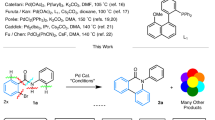Summary
The synthesis of a series of symmetrical disulfides as potential substrates of trypanothione reductase and glutathione reductase was described. The key intermediate in the synthetic approach was the choice of S-tbutylmercapto-L-cysteine (1). The spermidine ring in the native substrate, trypanothione disulfide (TSST), was replaced with 3-dimethyl-aminopropylamine (DMAPA), while theγ-Glu moiety was replaced by phenylalanyl or tryptophanyl residues. The same modifications in theγ-Glu moiety of glutathione disulfide (GSSG) were applied.
Similar content being viewed by others
References
Benson TJ, McKie JH, Garforth J, Borges A, Fairlamb AH, Douglas KT (1992) Rationally designed selective inhibitors of trypanothione reductase. Biochem J 286: 9–11
Bitter S, Knobler Y, Frankel M (1965) Activeα-aminoacyl O derivatives of N-substituted hydroxylamine, O to N migration and a method for peptide synthesis. Tetrahedron Lett 2: 95–98
Cleland WW (1964) Dithiothreitol, a new protective reagent for SH groups. Biochemistry 3: 480–482
EL-Waer A, Douglas KT, Smith K, Fairlamb AH (1991) Synthesis of N-benzyl-oxycarbonyl-L-cysteinylglycine 3-dimethylaminopropylamide disulfide: a cheap and convenient new assay for trypanothione reductase. Anal Biochem 198: 212–216
Fairlamb AH (1985) Trypanothione metabolism in the chemotherapy of leishmanias and trypanosomiasis. In: Wang CC (ed) Molecular & immunological aspects of parasitism, chapter 10. pub AAAS, pp 107–121
Garforth J, McKie JH, Jaouhari R, Benson TJ, Fairlamb AH, Douglas KT (1994) Rational design of peptide-based inhibitors of trypanothione reductase as potential antitrypanosomal drugs. Amino Acids 6: 295–299
Hunter WN, Bailey S, Habash J, Harrop SJ, Helliwell JR, Aboagye-Kwarteng T, Smith K, Fairlamb AH (1992) Active site of trypanothione reductase, a target for rational drug design. J Mol Biol 227: 322–333
Itoh M, Hagiwara D, Kamiya T (1975) A newt-butyloxycarbonylation reagent, 2t-butyloxycarbonyloxyimino-2-phenylacetonitrile. Tetrahedron Lett 49: 4393–4394
Mehta A, Jaouhari R, Benson TJ, Douglas KT (1992) Improved efficiency and selectivity in peptide synthesis: use of triethylsilane as a carbocation scavenger in deprotection oft-butyl esters andt-butoxycarbonyl-protected sites. Tetrahedron Lett 33: 5441–5444
Schirmer HR, Muller JG, Krauth-Siegel RL (1995) Disulfide-reductase as chemotherapeutic agents: the design of drugs fot trypanosomiasis and malaria. Angew Chem Int Ed 34: 141–154
Walsh C, Bradley M, Nadeau K (1991) Molecular studies of trypanothione reductase, a target for antiparasitic drugs. Trends Biochem Sci 16: 305–309
Author information
Authors and Affiliations
Rights and permissions
About this article
Cite this article
Jaouhari, R., Besheya, T., McKie, J.H. et al. Synthesis of symmetric disulfides as potential alternative substrates for trypanothione reductase and glutathione reductase: Part 1. Amino Acids 9, 327–342 (1995). https://doi.org/10.1007/BF00807270
Received:
Accepted:
Issue Date:
DOI: https://doi.org/10.1007/BF00807270




